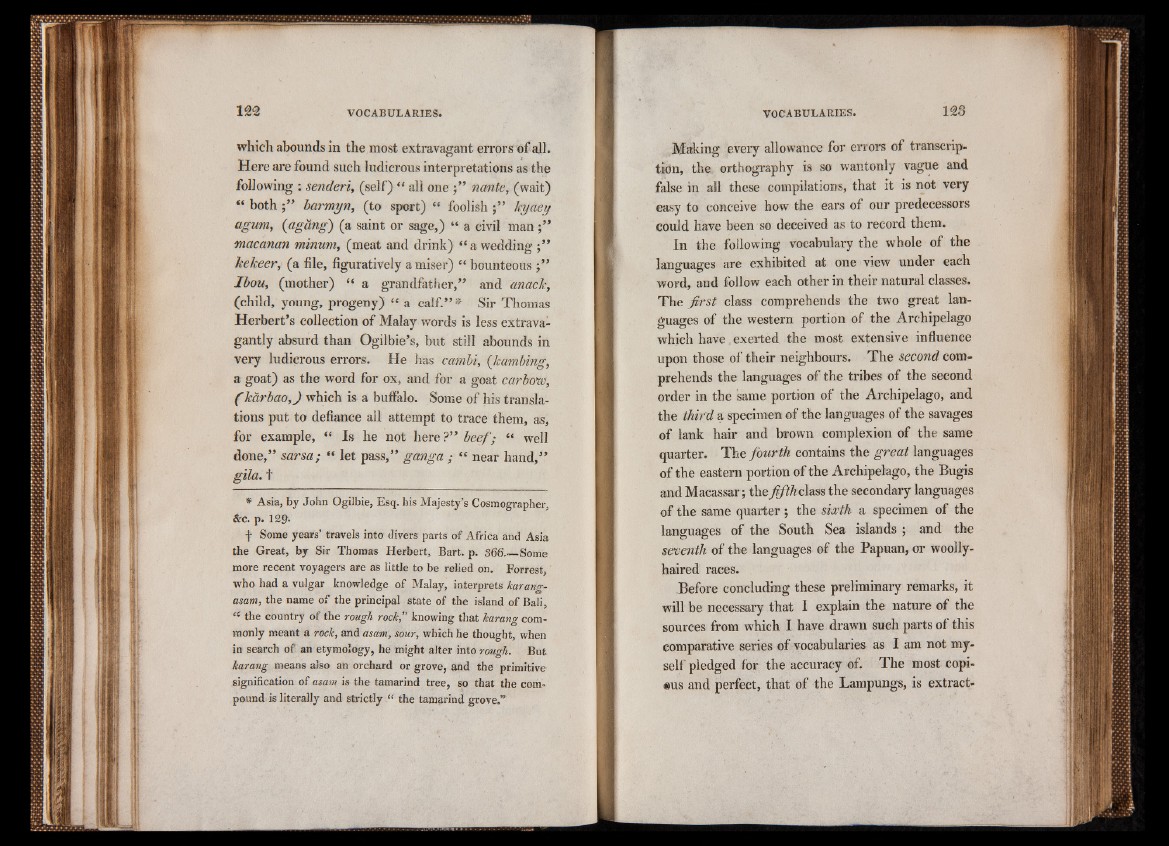
which abounds in the most extravagant error sof all.
Here are found such ludicrous interpretations as the
following : senderi, (self) “ all one f* nante, (wait)
“ both;” barmyn, (to sport) “ foolish ;” kyaey
agum, (agang) (a saint or sage,) “ a civil man;”
macanan minum, (meat and drink) “ a wedding ;”
kekeer, (a file, figuratively a miser) ** bounteousj”
Ibou, (mother) “ a grandfather,” and anaclc,
(child, young, progeny) “ a calf.” * Sir Thomas
Herbert’s collection of Malay words is less extravagantly
absurd than Ogilbie’s, but still abounds in
very ludicrous errors. He has cambi, (hambing,
a goat) as the word for ox, and for a goat carbow,
( kdrbao,) which is a buffalo. Some of his translations
put to defiance all attempt to trace them, as,
for example, “ Is he not here?” beef; “ well
done,” sarsa; “ let pass,” ganga ; “ near hand,”
gila. t
* Asia, by John Ogilbie, Esq. his Majesty’s Cosmographer,
&c. p. 12<h
f Some years’ travels into divers parts of Africa and Asia
the Great, by Sir Thomas Herbert, Bart. p. 366. Some
more recent voyagers are as littie to be relied on. Forrest,
who had a vulgar knowledge of Malay, interprets karang-
asam, the name of the principal state of the island of Bali,
e{ the country of the rough rock,” knowing that karang commonly
meant a rock, and asam, sour, which he thought, when
in search of an etymology, he might alter into rough. But
karang means also an orchard or grove, and the primitive
signification of asam is the tamarind tree, so that the com*
pound is literally and strictly “ the tamarind grove.”
Making every allowance for errors of transcription,
the orthography is so wantonly vague and
false in all these compilations, that it is not very
easy to conceive how the ears of our predecessors
could have been so deceived as to record them.
In the following vocabulary the whole of the
languages are exhibited at one view under each
word, and follow each other in their natural classes.
The first class comprehends the two great languages
of the western portion of the Archipelago
which have. exerted the most extensive influence
upon those of their neighbours. The second comprehends
the languages of the tribes of the second
order in the same portion of the Archipelago, and
the third a specimen of the languages of the savages
of lank hair and brown complexion of the same
quarter. The fourth contains the great languages
of the eastern portion of the Archipelago, the Bugis
and Macassar; thefifthd&ss the secondary languages
of the same quarter ; the sixth a specimen of the
languages of the South Sea islands ; and the
seventh of the languages of the Papuan, or woollyhaired
races.
Before concluding these preliminary remarks, it
will be necessary that 1 explain the nature of the
sources from which I have drawn such parts of this
comparative series of vocabularies as I am not myself
pledged for the accuracy of. The most copious
and perfect, that of the Lampungs, is extract